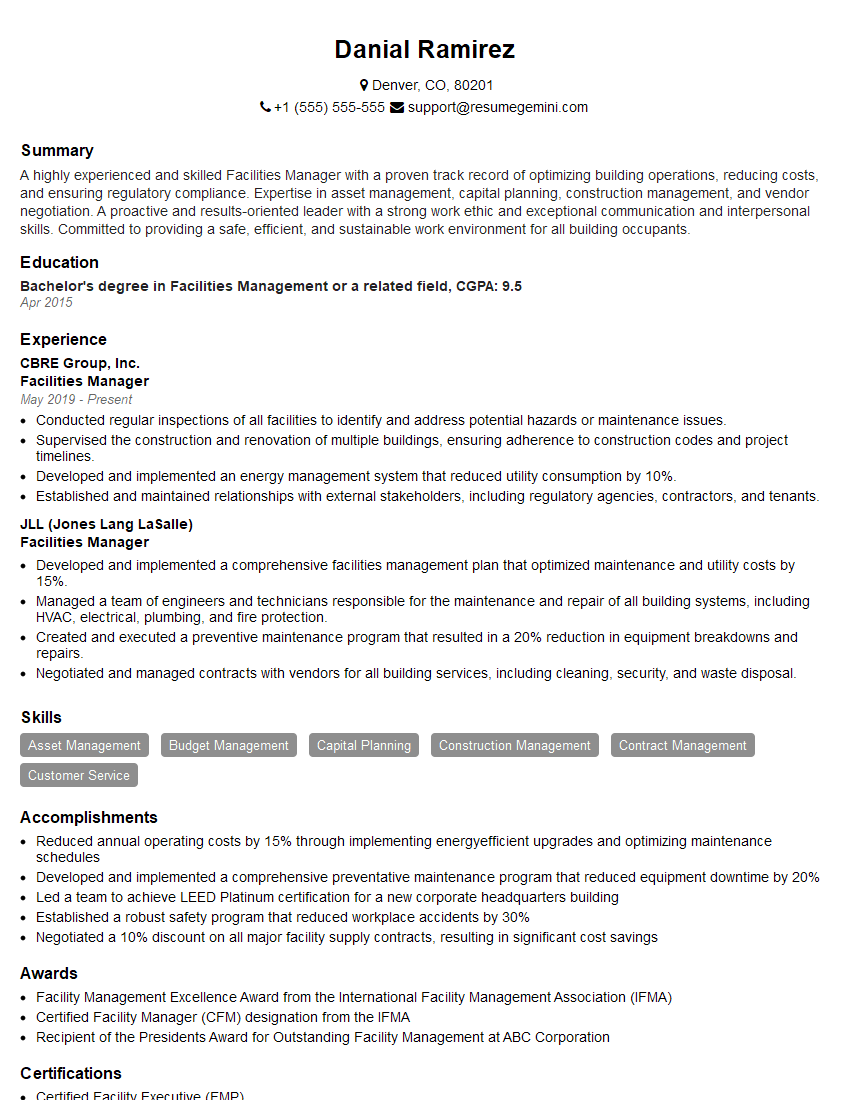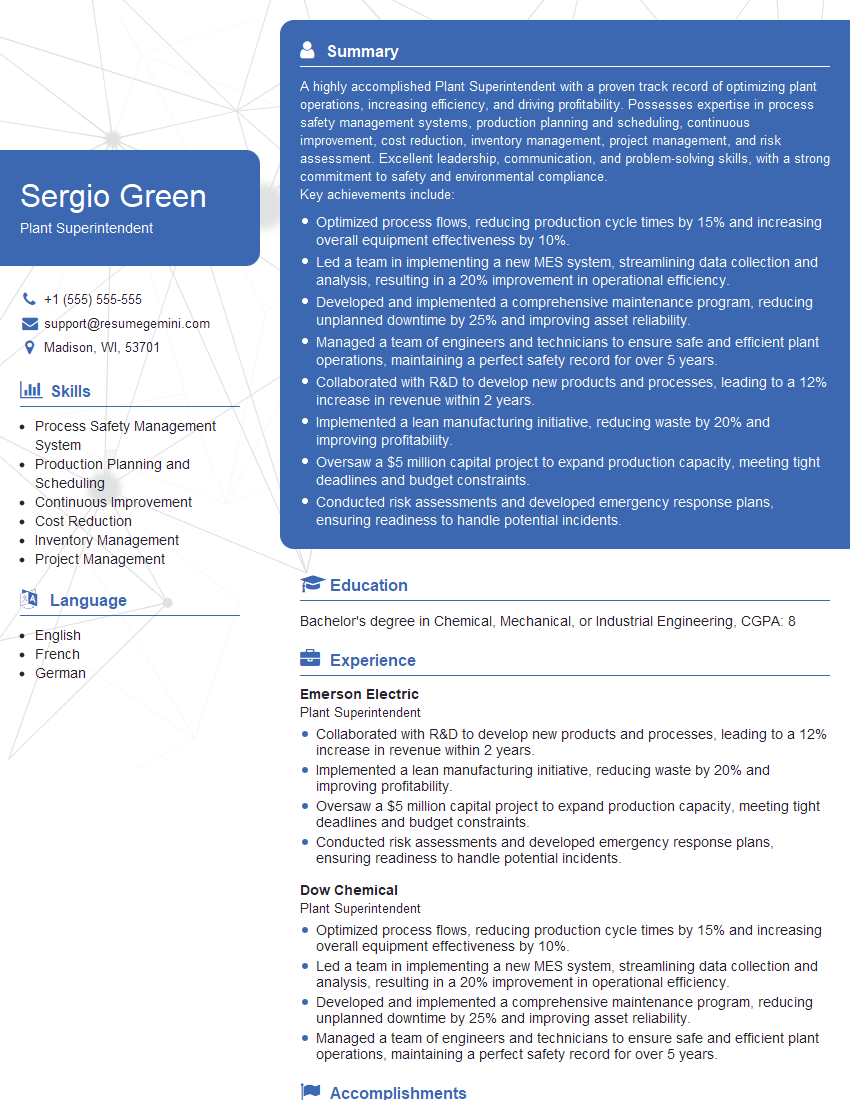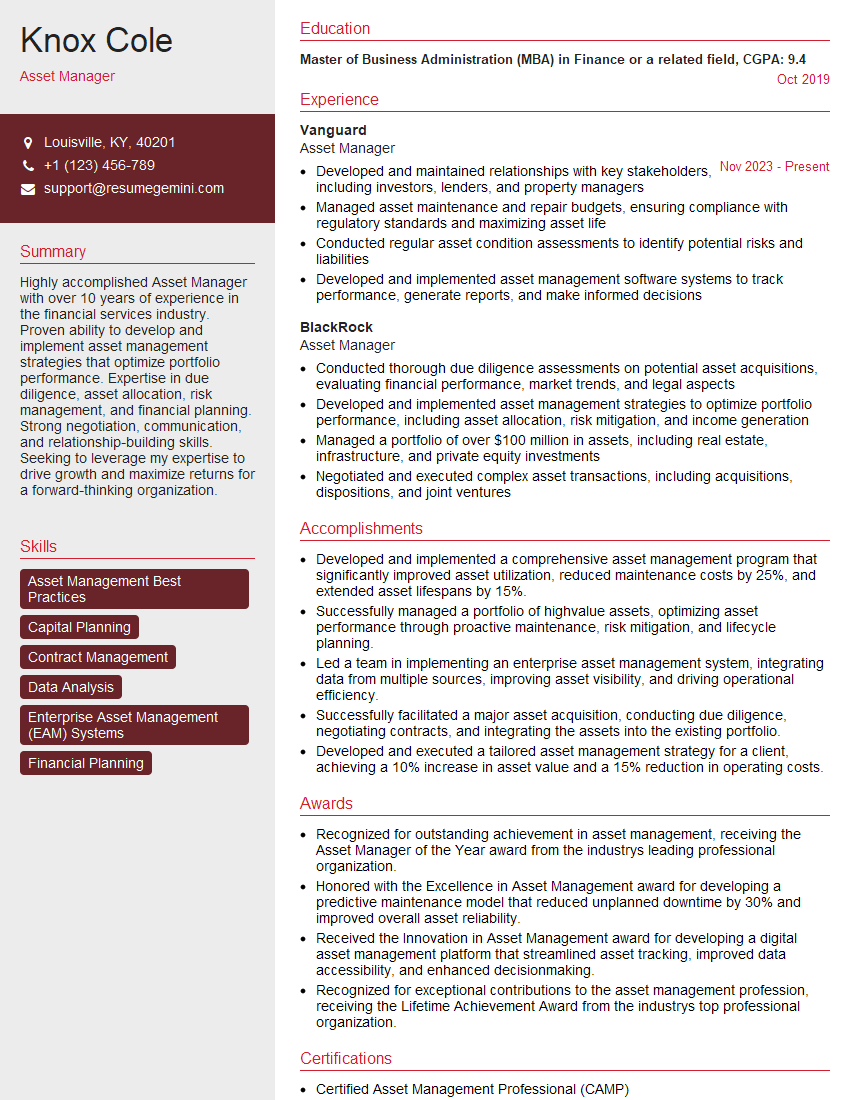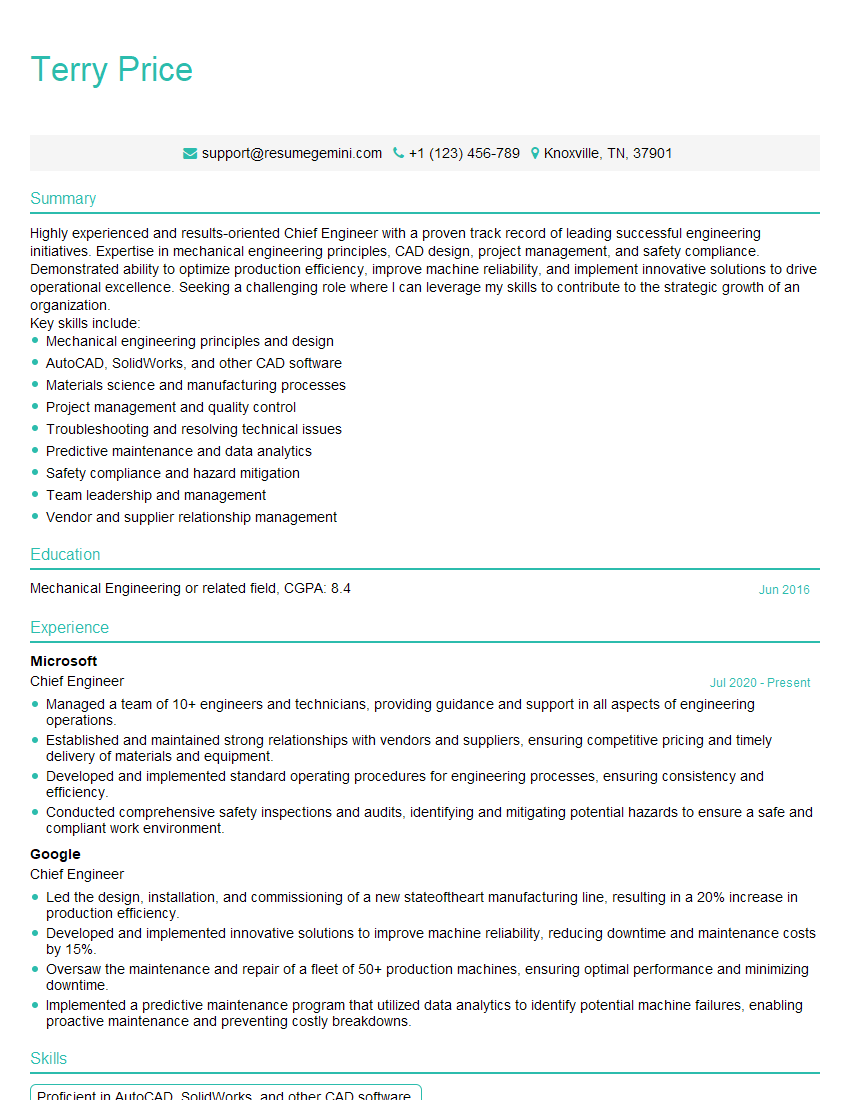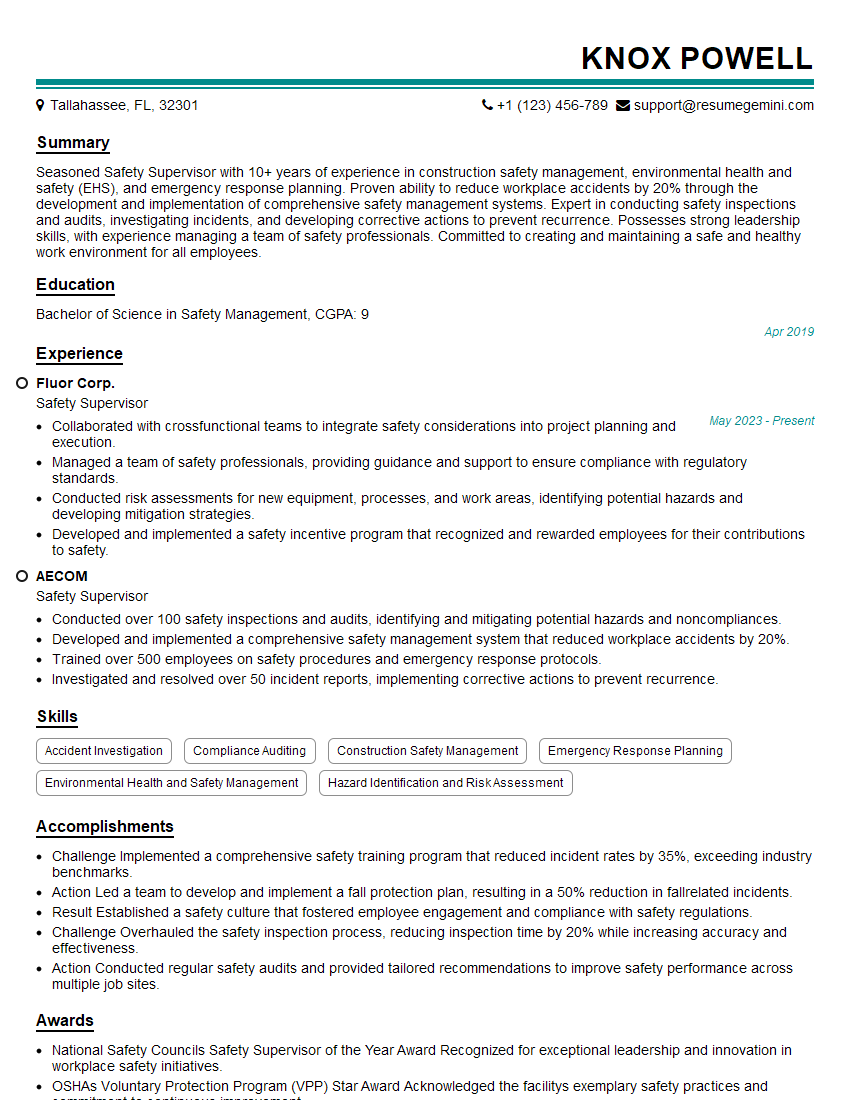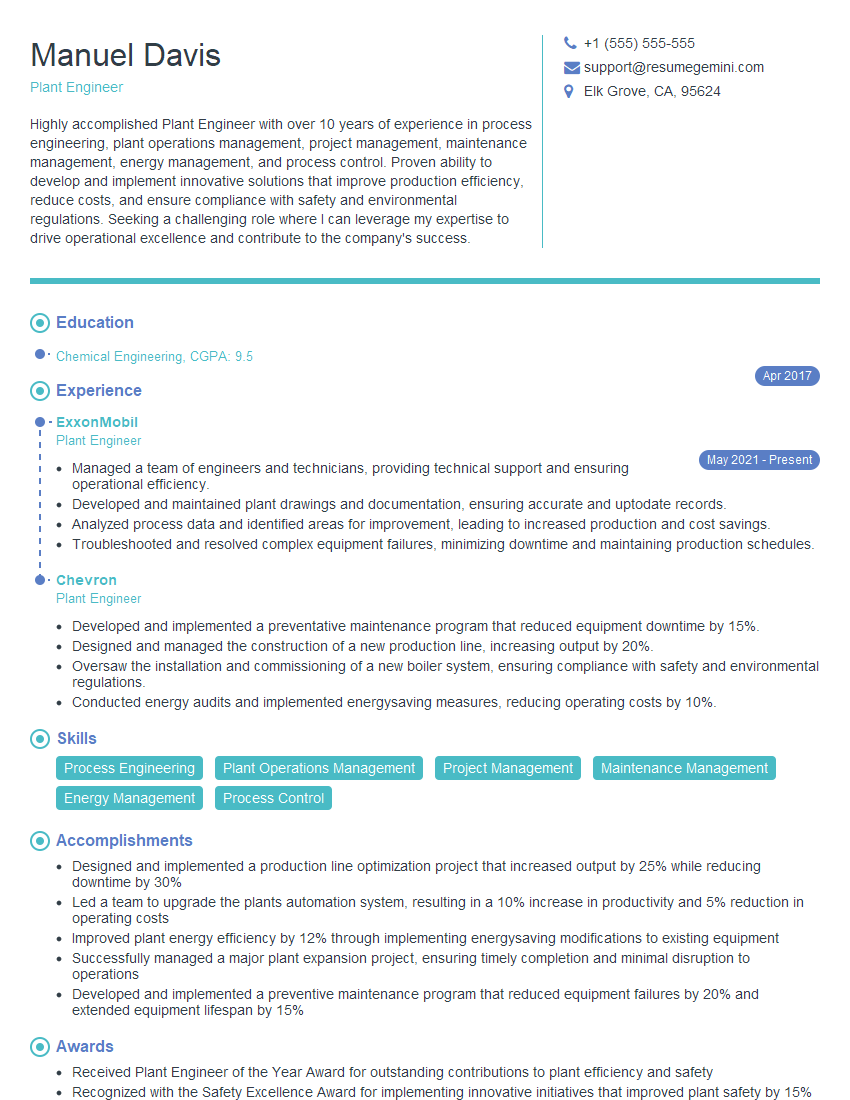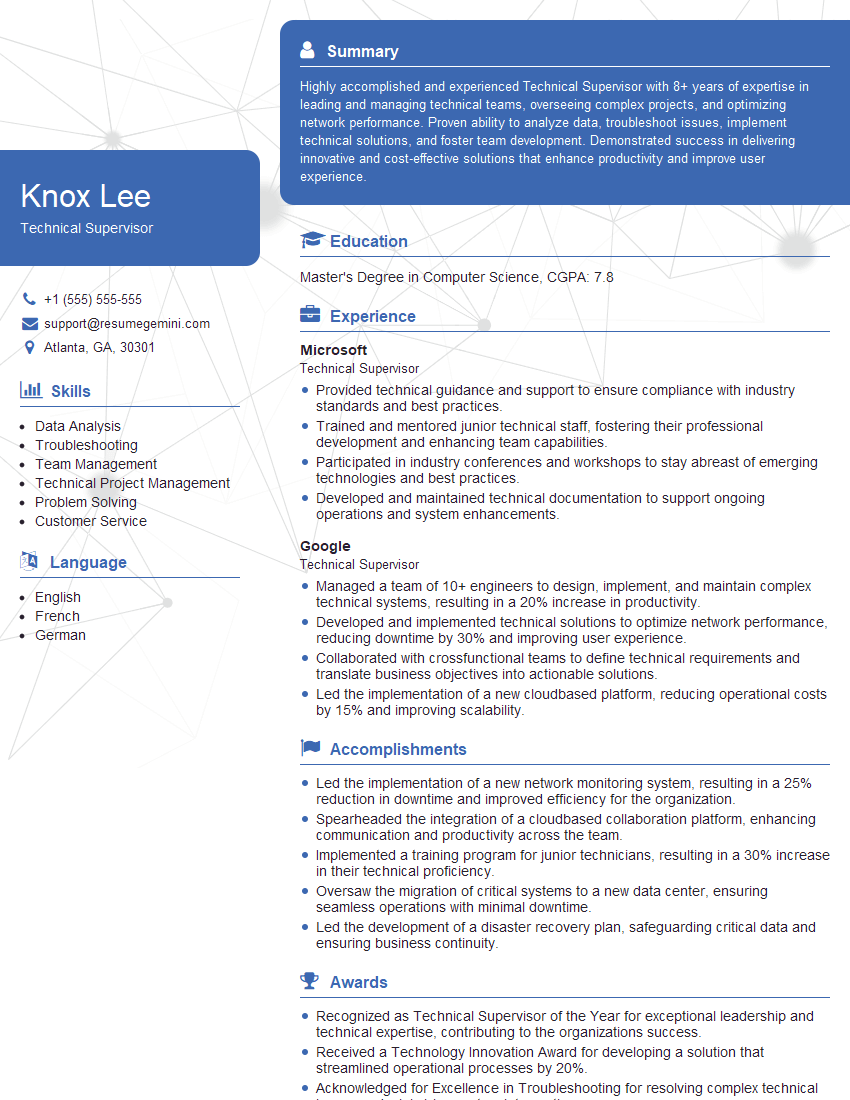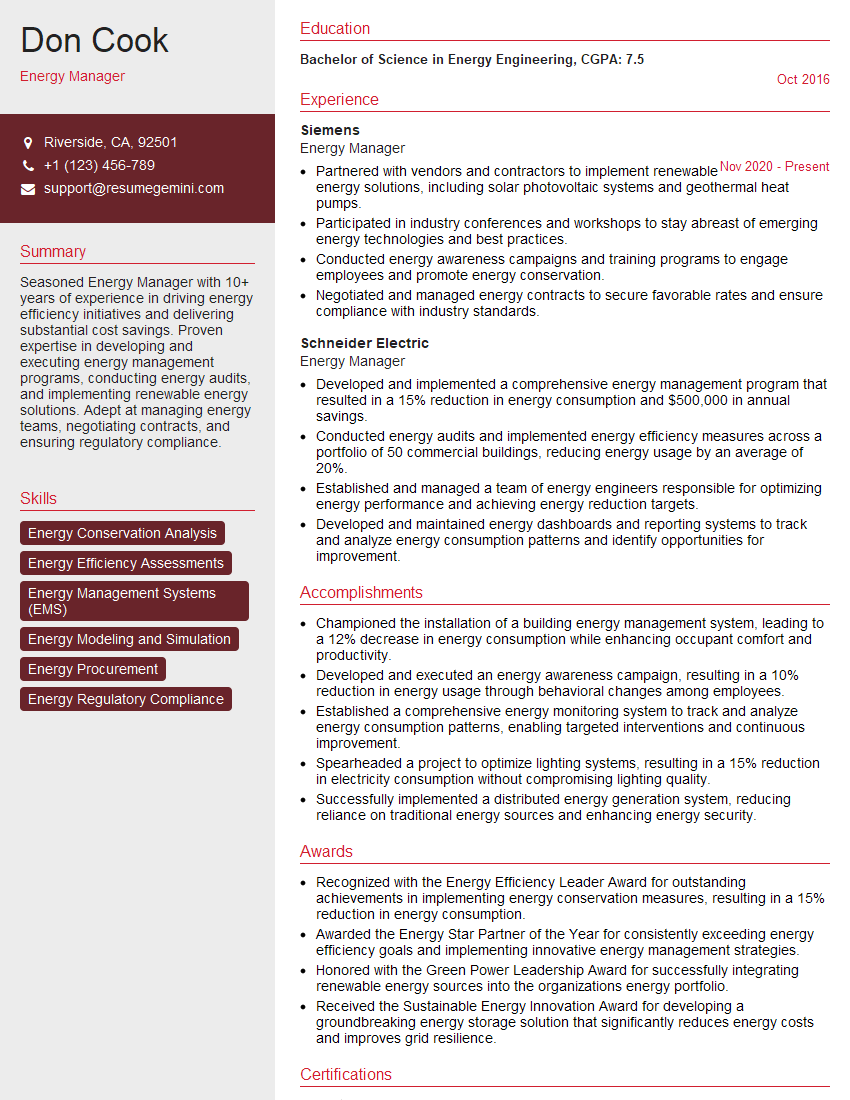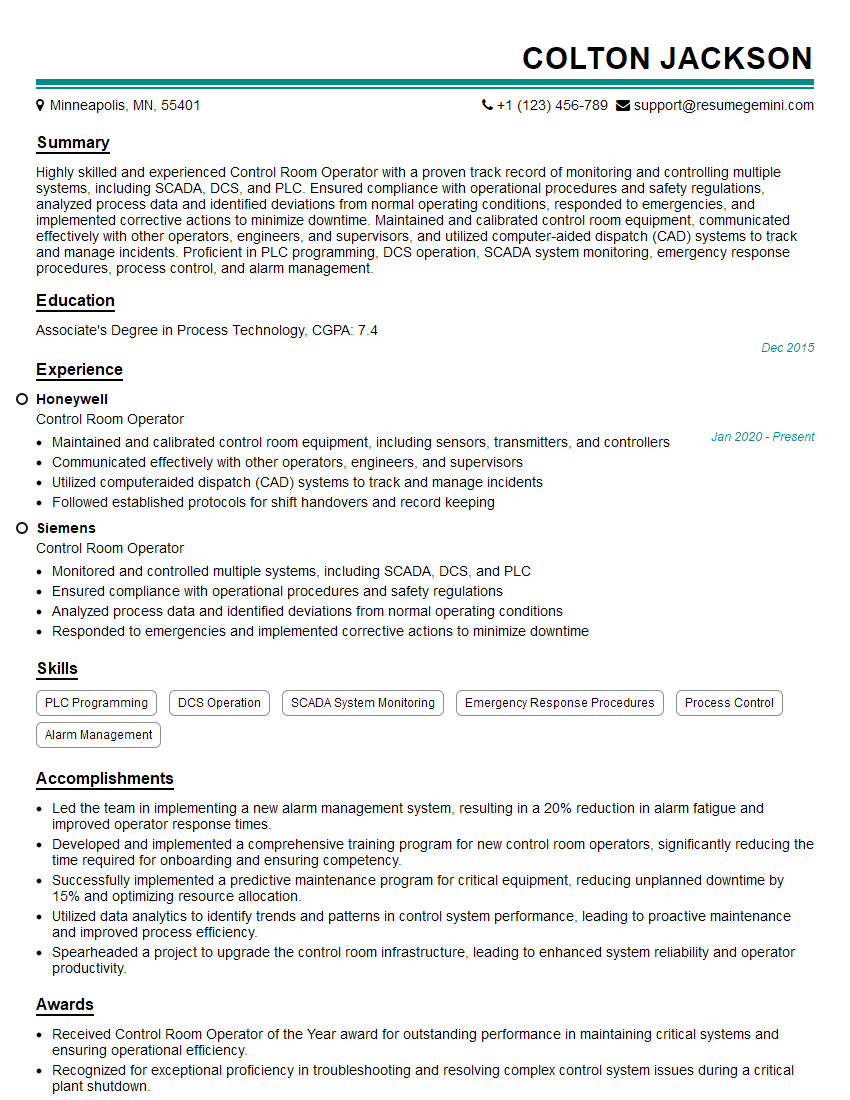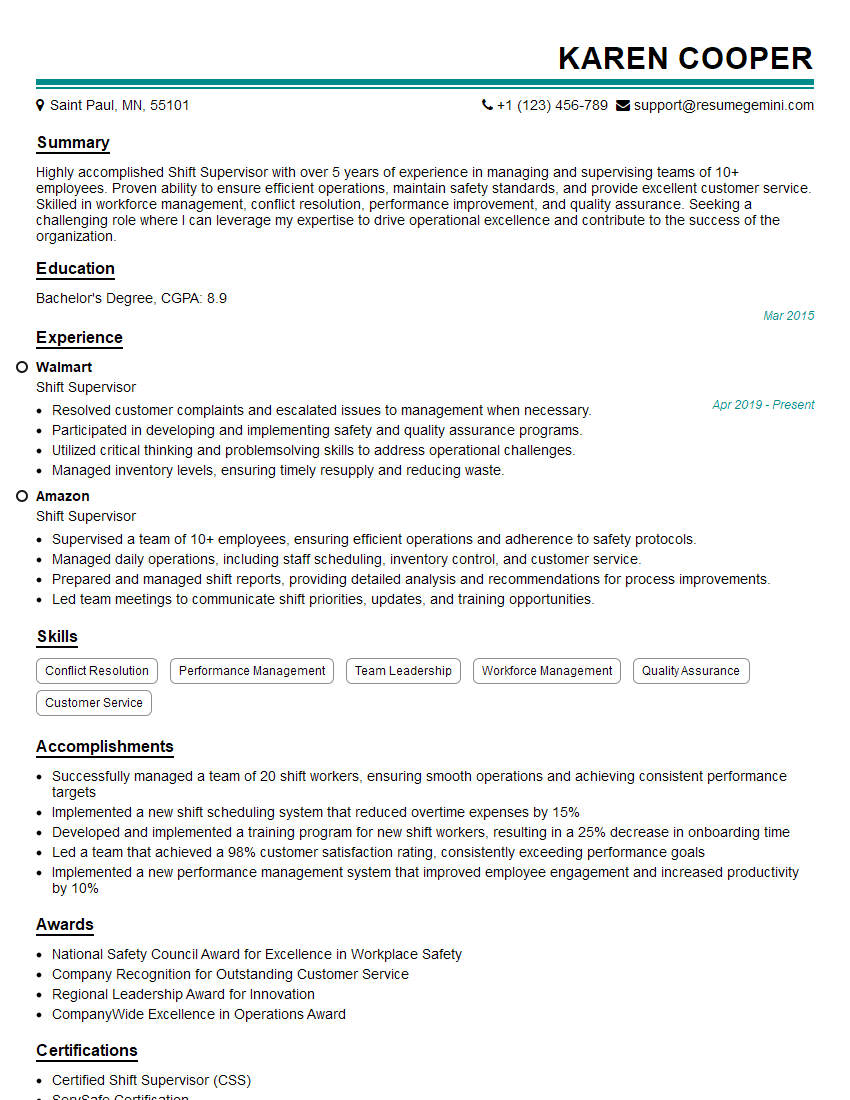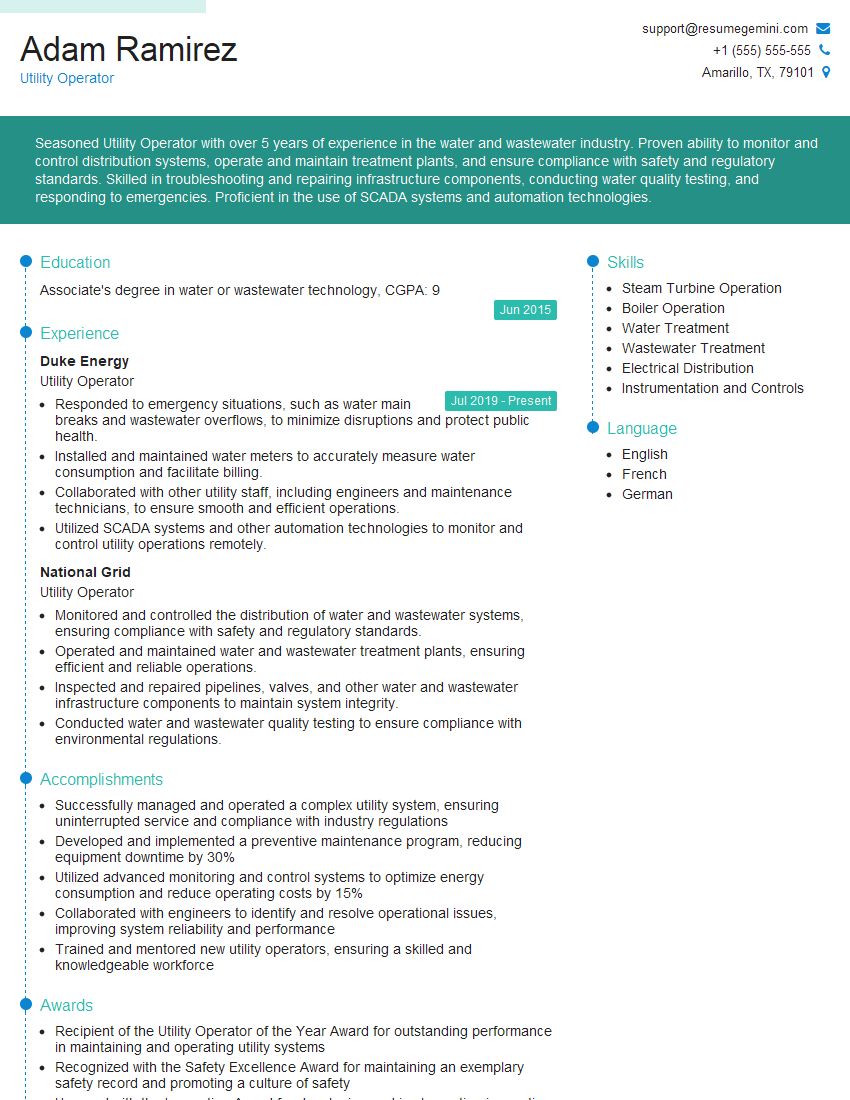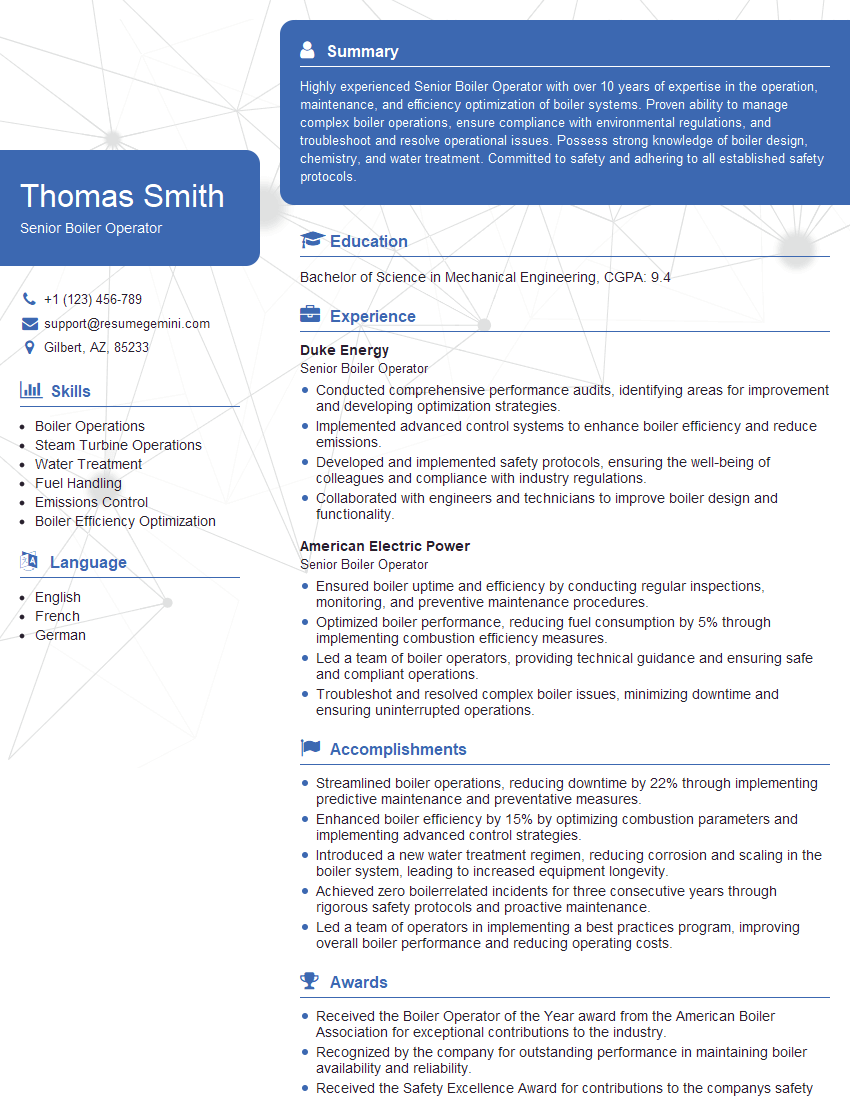Unlock your full potential by mastering the most common Boiler Shutdown and Deactivation interview questions. This blog offers a deep dive into the critical topics, ensuring you’re not only prepared to answer but to excel. With these insights, you’ll approach your interview with clarity and confidence.
Questions Asked in Boiler Shutdown and Deactivation Interview
Q 1. Describe the step-by-step procedure for a normal boiler shutdown.
A normal boiler shutdown is a systematic process designed to safely and efficiently bring a boiler offline. Think of it like carefully cooling down a pot of boiling water – you wouldn’t just dump it in the sink! The process involves several key steps performed in a specific order to prevent damage to the boiler and ensure personnel safety.
- Reduce Fuel Supply: Gradually decrease the fuel supply to the boiler, allowing the steam pressure to begin dropping slowly. This prevents thermal shock.
- Reduce Load: If the boiler is connected to a system, gradually reduce the demand or load on the boiler to further decrease pressure. This is often done by diverting steam to other parts of the system or reducing the overall system pressure.
- Monitor Pressure and Temperature: Continuously monitor the pressure and temperature gauges to ensure a controlled and safe reduction. Maintain a slow and steady decline, avoiding rapid changes.
- Open Bleeder Valves: Carefully open the bleeder valves to gradually release steam and further depressurize the boiler. This ensures controlled pressure reduction and prevents vacuum formation.
- Isolate Boiler Feedwater: Shut off the boiler feedwater supply to prevent further water from entering the boiler.
- Check Water Level: Verify the water level is within the safe operational range. An overly low level can lead to overheating during cooldown.
- Close Fuel Valves: Once the pressure and temperature are sufficiently low, completely shut off the fuel supply.
- Allow Natural Cooling: Allow the boiler to cool down naturally. Forcing the cooling process too quickly can cause damage.
- Final Checks: After sufficient cooling, conduct a thorough inspection for any leaks or damage.
Each step is crucial; deviating from this procedure can result in serious consequences.
Q 2. What are the safety precautions to be taken before initiating a boiler shutdown?
Safety is paramount before initiating any boiler shutdown. Imagine shutting down a powerful machine; you wouldn’t want to do it carelessly. Prior to shutdown, these precautions are essential:
- Lockout/Tagout (LOTO): Implement a robust lockout/tagout procedure to prevent accidental start-up. This involves physically locking out all power and control systems to the boiler.
- Isolate the Boiler: Isolating the boiler from the main steam system and any connected equipment prevents the accidental flow of steam or water into the shut-down boiler.
- Personnel Clearance: Ensure that all personnel are clear from the boiler area and any potentially hazardous zones. This includes notifying other operators and maintenance personnel.
- Personal Protective Equipment (PPE): Ensure all personnel involved wear appropriate PPE, including heat-resistant gloves, safety glasses, and closed-toe shoes.
- Emergency Shutdown Procedures: Verify the emergency shutdown systems are functioning correctly and readily accessible.
- Check Pressure and Temperature Readings: Confirm accurate readings before beginning the shutdown process; incorrect readings may lead to wrong decisions.
- Document the Process: Maintain clear records of the shutdown process, including timestamps, pressure and temperature readings, and any observed anomalies.
These procedures help avoid accidents and ensure a controlled shutdown process.
Q 3. Explain the importance of depressurization during a boiler shutdown.
Depressurization is crucial for safe boiler shutdown. It’s like slowly releasing air from a pressurized container – doing it quickly can cause damage or even explosions. The main reasons include:
- Preventing Thermal Shock: Rapid depressurization causes a sudden temperature drop, leading to thermal stress on the boiler components, potentially causing cracking or warping. Gradual depressurization allows the boiler to cool evenly.
- Preventing Vacuum Formation: A rapid pressure drop can create a vacuum inside the boiler, which can collapse boiler tubes or cause other damage.
- Maintaining Control: Controlled depressurization allows for easier monitoring of the boiler’s condition during the shutdown process. Operators can carefully observe the pressure and temperature gauges to ensure a safe and orderly procedure.
- Safety for Personnel: Controlled depressurization significantly reduces the risk of steam releases and other hazards to personnel.
Ignoring depressurization can result in costly repairs or even catastrophic failure.
Q 4. How do you handle unexpected events during a boiler shutdown?
Unexpected events during a shutdown require immediate, decisive action. Think of it as responding to a fire drill – your response plan should be ready. For instance, a sudden pressure surge might indicate a valve malfunction. Here’s how to handle them:
- Identify the Problem: Quickly assess the situation and identify the cause of the unexpected event. Consult pressure, temperature and other relevant readings.
- Implement Emergency Procedures: If necessary, initiate emergency shutdown procedures, prioritizing the safety of personnel and equipment.
- Isolate Affected Sections: If possible, isolate the affected sections of the system to prevent further problems. This might include closing valves to contain any steam leaks.
- Call for Assistance: Immediately call for assistance from maintenance personnel or other qualified experts.
- Document the Event: Thoroughly document the unexpected event, including the time, the nature of the problem, actions taken, and any resulting damage. This is critical for future analysis and preventing similar occurrences.
A well-defined emergency response plan is crucial for handling unforeseen circumstances.
Q 5. What are the different types of boiler shutdowns?
Boiler shutdowns aren’t all the same; the approach depends on the circumstances. Here are some common types:
- Normal Shutdown: A planned, routine shutdown as described previously.
- Emergency Shutdown: A rapid shutdown initiated due to a critical fault or unsafe condition, such as a pressure surge, high temperature alarm, or equipment failure. This involves prioritizing safety and halting operation as quickly as possible.
- Planned Maintenance Shutdown: A shutdown scheduled for routine maintenance or repairs. This usually involves more extensive procedures and preparation.
- Partial Shutdown: Shutting down only a portion of a boiler system while other parts remain operational. This might be done for repairs or during periods of reduced demand.
The procedure for each type varies, emphasizing the need for clear guidelines and training.
Q 6. Describe the process for isolating the boiler from the system.
Isolating the boiler involves separating it from the rest of the system to prevent any accidental flow of steam or water. This step is crucial for safety and maintenance. It’s like turning off a single tap in a complex plumbing system.
- Close Main Steam Stop Valves: These valves cut off the flow of steam from the boiler to the steam header and distribution system.
- Close Feedwater Valves: Shut off the flow of water into the boiler.
- Close Blowdown Valves: These valves are used to drain water from the boiler, and should be closed to prevent accidental drainage during shutdown.
- Verify Isolation: After closing the valves, verify their status visually and, if possible, using instrumentation to confirm that they are fully closed and no steam or water is flowing.
- Lockout/Tagout: Once the valves are closed, apply lockout/tagout devices to prevent unauthorized access or operation.
Failure to properly isolate can lead to hazardous situations. Double-checking is always recommended.
Q 7. How do you verify the complete shutdown of a boiler?
Verifying complete shutdown involves confirming that the boiler is safely and completely offline. This is not just about turning off the fuel; it’s about ensuring everything is stable. It’s like double-checking you’ve turned off all appliances before leaving your house.
- Pressure and Temperature Checks: Verify that both pressure and temperature have dropped to safe levels and are stable. Refer to the boiler’s operating manual for acceptable values.
- Visual Inspection: Conduct a visual inspection for leaks, unusual sounds, or any signs of damage or malfunction.
- Verify Valve Positions: Confirm that all isolation valves are fully closed and locked out/tagged out.
- Check Fuel Supply: Ensure the fuel supply is completely shut off and the fuel line is depressurized, if applicable.
- Documentation: Record all readings and observations in the boiler logbook, including the time of shutdown and the status of all relevant parameters.
Complete shutdown verification is a critical safety measure, providing assurance that the boiler is safely offline.
Q 8. What are the potential hazards associated with improper boiler shutdown?
Improper boiler shutdown can lead to a range of serious hazards, some potentially catastrophic. Think of it like this: a boiler is a pressurized vessel containing superheated water or steam – a powerful and dangerous combination if not handled correctly.
- Thermal Burns: Accidental contact with hot surfaces, steam, or water during improper cool-down can cause severe burns.
- Pressure Vessel Damage: Rapid depressurization or uneven cooling can lead to cracks, warping, or even explosions in the boiler vessel.
- Equipment Damage: Incorrect procedures can damage valves, pumps, and other associated equipment, leading to costly repairs and downtime.
- Environmental Hazards: Improper shutdown can lead to the release of harmful substances into the atmosphere or surrounding environment, such as steam, chemicals, or pollutants.
- Personnel Injuries: A combination of the above hazards poses significant risks to the safety of personnel involved in the shutdown process.
For example, neglecting to properly vent the system before opening it could result in a steam explosion, causing serious injury or death. Similarly, failing to isolate the boiler from the rest of the system before commencing maintenance could lead to unexpected pressure surges and damage.
Q 9. Explain the role of lockout/tagout procedures in boiler shutdown.
Lockout/Tagout (LOTO) procedures are crucial for safe boiler shutdown. These procedures are designed to prevent the accidental energization or startup of equipment while maintenance or repair work is being performed. Imagine a scenario where someone inadvertently starts the boiler while another person is inside working on a component – the consequences would be disastrous.
In the context of boiler shutdown, LOTO involves several steps:
- Isolation: Isolating the boiler from all energy sources (fuel, electricity, steam lines).
- Lockout: Applying physical locks to the isolating devices to prevent their operation.
- Tagout: Attaching clear and concise tags to the locks, indicating who locked out the equipment and why.
- Verification: Verifying that the boiler is truly de-energized and safe to work on.
- Release: Following the completion of work, only the person who performed the lockout can release the equipment.
LOTO is not just a procedure; it’s a safety culture that emphasizes the importance of preventing accidents. It’s a legal requirement in many jurisdictions and is essential for maintaining a safe working environment.
Q 10. How do you ensure the safety of personnel during a boiler shutdown?
Ensuring personnel safety during a boiler shutdown requires a multi-faceted approach, combining strict adherence to procedures with proper training and equipment.
- Proper Training: All personnel involved must receive thorough training on the specific procedures for the type of boiler and the associated hazards.
- Personal Protective Equipment (PPE): Appropriate PPE, such as heat-resistant gloves, eye protection, and safety footwear, must be provided and used.
- Clear Communication: Effective communication channels and a clear chain of command are vital to coordinate the actions of all personnel involved.
- Emergency Procedures: Emergency response plans, including procedures for dealing with leaks, fires, or other emergencies, should be established and regularly reviewed.
- Confined Space Entry Procedures: If entry into the boiler or any confined spaces is required, strict confined space entry procedures must be followed.
Consider this: A well-defined communication strategy can save lives. Using pre-defined hand signals and communication protocols during the shutdown process minimizes the risk of misunderstandings that can lead to accidents.
Q 11. What are the environmental considerations during boiler shutdown?
Environmental considerations during boiler shutdown are essential to prevent pollution and ensure compliance with regulations. The key focus is on minimizing the release of harmful substances into the environment.
- Water Discharge: The discharge of boiler blowdown water must comply with environmental regulations. This may involve treatment of the water to remove pollutants before discharge.
- Air Emissions: During shutdown, steps must be taken to prevent the release of harmful gases or particulate matter into the atmosphere. This could involve the use of specialized filters or emission control systems.
- Waste Disposal: Any waste materials generated during the shutdown process, such as spent chemicals or cleaning agents, must be disposed of properly, in accordance with relevant regulations.
- Fuel Handling: The safe handling and storage of fuel during shutdown are also crucial to avoid spills or leaks that could contaminate the environment.
For example, a company might need to obtain permits before discharging any treated or untreated water and must maintain accurate records of discharges to ensure compliance with regulatory limits.
Q 12. How do you document the boiler shutdown process?
Meticulous documentation of the boiler shutdown process is critical for safety, maintenance, and legal compliance. This documentation serves as a record of the events and helps to identify any areas for improvement in future shutdowns.
Documentation should include:
- Date and time of the shutdown initiation.
- Reasons for the shutdown (planned or unplanned).
- Step-by-step record of the shutdown procedure followed.
- Measurements of key parameters (pressure, temperature, water levels) at different stages.
- Personnel involved in the shutdown process.
- Any deviations from the standard shutdown procedure and the reasons for them.
- Observations regarding the condition of the boiler and associated equipment.
- Signatures or initials of personnel confirming completion of tasks.
Think of it as a detailed story of the shutdown, with timestamps and signatures for verification. This detailed record is crucial for analysis in case of future incidents or for future maintenance scheduling.
Q 13. What are the common causes of boiler trips?
Boiler trips, or unexpected shutdowns, can be caused by a variety of factors, often related to safety interlocks or operational malfunctions.
- High Pressure: The boiler pressure exceeding the set limit will cause an automatic shutdown to prevent an explosion.
- Low Water Level: A critically low water level can lead to overheating and damage, triggering an emergency shutdown.
- High Temperature: Similar to high pressure, exceeding the maximum allowable temperature will trigger a safety shutdown.
- Flame Failure: If the burner fails to ignite or the flame goes out, this will cause an automatic shutdown to prevent the production of harmful gases.
- Electrical Malfunctions: Problems with the boiler’s electrical system, such as short circuits or power failures, can also cause a trip.
- Safety Interlocks: Various safety sensors and interlocks monitor critical parameters; if any of these systems detect an unsafe condition, they will trigger a shutdown.
Troubleshooting boiler trips requires a systematic approach, carefully checking each component and system to determine the root cause.
Q 14. Describe the process for restarting a boiler after shutdown.
Restarting a boiler after shutdown is a careful and controlled process that mirrors, in reverse, the shutdown procedure. It’s important to remember that safety remains paramount.
The process generally involves:
- Inspection: Thorough inspection of the boiler and all associated equipment to ensure there is no damage from the previous shutdown.
- System Checks: Checking water levels, fuel supply, electrical connections, and safety systems.
- Pre-purge: If necessary, purging the system of any accumulated gases.
- Fill and Prime: Filling the boiler with water and priming the pumps.
- Start-up Sequence: Following the manufacturer’s recommended start-up procedure, gradually increasing the temperature and pressure.
- Monitoring: Carefully monitoring all parameters (pressure, temperature, water levels) during the startup process.
- Load Increase: Gradually increasing the load on the boiler to its desired operating level.
Each step must be performed meticulously according to established procedures, and any deviations must be documented. Think of it as a gradual awakening of a sleeping giant – a slow and steady process is key to avoiding problems.
Q 15. What are the regulatory requirements for boiler shutdown procedures?
Regulatory requirements for boiler shutdown procedures vary depending on location and boiler type, but generally involve adherence to local, national, and potentially international safety standards. These regulations aim to prevent accidents, minimize environmental impact, and ensure safe and efficient decommissioning. Key aspects typically covered include:
- Permitting and Notifications: Obtaining necessary permits before commencing shutdown, often involving notifying relevant authorities like environmental protection agencies.
- Lockout/Tagout (LOTO) Procedures: Implementing strict LOTO procedures to isolate energy sources (fuel, electricity, steam) to prevent accidental restarting or energization during shutdown.
- Step-by-Step Procedures: Following documented, detailed shutdown procedures specific to the boiler type and size, including cooling protocols, pressure release, and depressurization steps.
- Emission Controls: Meeting emission standards during shutdown, particularly concerning the release of potentially hazardous substances.
- Waste Disposal: Safe and compliant disposal of any waste generated during the process, adhering to environmental regulations.
- Record Keeping: Maintaining meticulous records of the entire shutdown process, including dates, times, personnel involved, and any deviations from the standard operating procedure.
Failure to comply with these regulations can result in significant fines, legal action, and potential harm to personnel and the environment. A comprehensive understanding of these requirements is crucial for safe and compliant boiler operations.
Career Expert Tips:
- Ace those interviews! Prepare effectively by reviewing the Top 50 Most Common Interview Questions on ResumeGemini.
- Navigate your job search with confidence! Explore a wide range of Career Tips on ResumeGemini. Learn about common challenges and recommendations to overcome them.
- Craft the perfect resume! Master the Art of Resume Writing with ResumeGemini’s guide. Showcase your unique qualifications and achievements effectively.
- Don’t miss out on holiday savings! Build your dream resume with ResumeGemini’s ATS optimized templates.
Q 16. How do you troubleshoot common problems during boiler shutdown?
Troubleshooting during boiler shutdown involves systematically identifying and resolving issues that impede the safe and efficient completion of the process. This often requires a combination of experience, technical knowledge, and the use of diagnostic tools. Here’s a common approach:
- Identify the Problem: Determine the specific problem preventing shutdown. Is the pressure not dropping? Is a valve stuck? Is there a safety interlock preventing further steps?
- Review Procedures: Carefully check the established shutdown procedure for the specific boiler to identify any steps that might be causing the problem or need adjustment.
- Inspect Equipment: Visually inspect relevant equipment, including valves, gauges, and safety devices. Look for leaks, obstructions, or damage.
- Consult Instrumentation: Use gauges, sensors, and control systems to obtain data about the boiler’s operating parameters to verify the problem and diagnose the root cause.
- Implement Corrective Actions: Based on the diagnosis, implement the necessary corrective actions. This might involve opening or closing valves, addressing leaks, resetting safety interlocks, or calling in specialist technicians if needed.
- Document Actions: Maintain a record of the problem, actions taken, and the outcome to improve future shutdown processes.
For instance, if a pressure relief valve fails to open during depressurization, it’s crucial to identify the cause – mechanical failure, obstruction, or a malfunction in the control system – and implement the appropriate corrective action, perhaps involving manual intervention under strict safety guidelines.
Q 17. What are the different types of boiler safety valves?
Boiler safety valves are critical components designed to protect the boiler from overpressure. Different types exist, categorized mainly by their operating mechanism:
- Spring-Loaded Safety Valves: These are the most common type. A spring resists the pressure within the boiler. When pressure exceeds a preset limit, the spring is overcome, and the valve opens, releasing steam to prevent catastrophic failure. They are relatively simple and reliable.
- Weight-Loaded Safety Valves: Similar to spring-loaded valves but use weights instead of a spring to control the opening pressure. Less common due to limitations in precise pressure control.
- Pilot-Operated Safety Valves: These valves use a pilot system to open and close the main valve. They are often used for high-pressure boilers or when precise control and remote operation are required. This pilot system can monitor pressure and initiate opening more quickly and reliably than spring-loaded designs.
- Balanced Bellows Safety Valves: These use a bellows to balance the pressure forces acting on the valve disc, ensuring consistent operation regardless of pressure fluctuations in the piping systems around the valve. They can operate with high accuracy.
Each type has its advantages and disadvantages in terms of cost, accuracy, and maintenance. The selection depends on the specific application and the requirements of the boiler system. Regular inspection and testing are essential for all types to ensure they function correctly when needed.
Q 18. Explain the purpose of a boiler blowdown system.
A boiler blowdown system is a crucial safety and efficiency feature designed to remove impurities, sludge, and dissolved solids from the boiler water. These impurities can accumulate over time and reduce boiler efficiency, potentially leading to scale formation, corrosion, and other problems. The system typically involves two types of blowdowns:
- Continuous Blowdown: A small, continuous stream of water is removed from the boiler, maintaining a constant level of purity. This helps prevent concentration of dissolved solids.
- Intermittent Blowdown: A periodic, larger volume of water is rapidly removed to flush out more significant accumulations of impurities. This is often used less frequently than continuous blowdown.
The blowdown water is usually discharged into a drain system, and in some cases, it may be treated before discharge to meet environmental regulations. Proper blowdown management contributes to optimized boiler performance, increased boiler lifespan, and environmental compliance.
Q 19. What are the key performance indicators (KPIs) for boiler shutdown efficiency?
Key Performance Indicators (KPIs) for boiler shutdown efficiency focus on safety, time, and resource usage. Effective shutdown minimizes risks and resource consumption.
- Shutdown Time: The total time taken to complete the shutdown process. Shorter shutdown times indicate greater efficiency.
- Fuel Consumption During Shutdown: The amount of fuel consumed during the shutdown sequence. Lower consumption indicates better efficiency.
- Water Consumption During Shutdown (Cooling Water): Similar to fuel, minimizing water usage during cooling enhances overall efficiency.
- Number of Safety Incidents: Tracking the number of safety incidents or near misses during shutdown. Zero incidents are the ideal target.
- Waste Generated: The volume of waste generated during the shutdown. Minimizing waste promotes environmental responsibility.
- Compliance with Regulations: Ensuring adherence to all safety and environmental regulations during the shutdown.
Tracking these KPIs allows for continuous improvement in shutdown procedures, ensuring safety and efficiency. Benchmarking against industry best practices can further optimize these processes.
Q 20. How do you manage waste generated during boiler shutdown?
Waste management during boiler shutdown is critical for environmental compliance and safety. The type and amount of waste generated depend on the boiler’s age, type, and the extent of maintenance involved. Common waste streams include:
- Spent Chemicals: Cleaning chemicals used during the shutdown and maintenance process.
- Sludge and Scale: Removed from the boiler during blowdown.
- Used Filters and Consumables: Filters, gaskets, and other consumables that need replacement during the process.
Managing this waste involves:
- Proper Segregation: Separating different types of waste to facilitate safe and appropriate disposal or recycling.
- Hazardous Waste Handling: Handling hazardous waste according to regulations, involving proper labeling, storage, and disposal by licensed contractors.
- Recycling and Recovery: Exploring opportunities to recycle or recover valuable materials from the generated waste.
- Documentation: Maintaining detailed records of waste generation, handling, and disposal to comply with regulations.
Failure to manage waste properly can result in environmental penalties and legal repercussions. A proactive approach to waste management during boiler shutdown is essential for environmental protection and responsible operations.
Q 21. Describe your experience with different types of boilers (e.g., water tube, fire tube).
My experience encompasses various boiler types, including water tube and fire tube boilers. I’ve worked extensively with different sizes and configurations, from small industrial boilers to large utility boilers.
- Water Tube Boilers: These boilers have water circulating inside tubes surrounded by hot gases. I’ve been involved in the shutdown procedures for various water tube boilers, including those with different designs such as D-type, O-type, and straight tube designs. The complexities associated with their large size and high pressure necessitate meticulous shutdown planning and execution.
- Fire Tube Boilers: Here, hot gases pass through tubes surrounded by water. I’ve worked with various fire tube boilers, from horizontal return tubular (HRT) boilers commonly found in smaller industrial settings to vertical fire tube boilers. Their smaller scale often allows for simpler shutdown procedures, but proper safety protocols remain crucial.
My experience also includes handling boilers fueled by different sources, including natural gas, oil, and coal, each presenting unique challenges during shutdown. I have a deep understanding of the specific considerations and procedures involved with each type, ensuring safe and efficient deactivation while minimizing environmental impact and adhering to all applicable regulations.
Q 22. How do you ensure the integrity of boiler components after shutdown?
Ensuring the integrity of boiler components after shutdown is crucial to prevent damage and ensure safe restart. It involves a multi-step process focused on controlled cooling, preventing corrosion, and maintaining structural soundness.
Controlled Cooling: Rapid cooling can cause thermal shock, leading to cracking in pressure vessels and tubes. We use a slow, controlled cooldown procedure, often monitored by thermocouples strategically placed throughout the boiler. The rate of cooling is carefully managed based on the boiler’s material and design. For example, a large industrial boiler might cool down over several hours or even a day.
Corrosion Prevention: Once the boiler is out of service, moisture and oxygen can cause rapid corrosion. To prevent this, we often introduce inert gases like nitrogen to displace the air and reduce oxygen levels inside the boiler. We might also use corrosion inhibitors to further protect the metal surfaces. Regular inspections for signs of corrosion are a critical part of this process.
Maintaining Structural Soundness: Regular inspections after shutdown are performed to check for any signs of damage, such as cracking, deformation, or erosion. This might involve visual inspections, ultrasonic testing, or other non-destructive testing methods. Any identified issues are documented and addressed before the boiler is restarted.
Q 23. What are the best practices for maintaining boiler shutdown logs and records?
Maintaining accurate and complete shutdown logs and records is vital for compliance, troubleshooting, and future maintenance planning. These logs serve as a historical record of the boiler’s operational history.
Detailed Information: Logs should include the date and time of shutdown, the reason for shutdown (planned maintenance, emergency, etc.), the steps followed during the shutdown process, the readings of key parameters (pressure, temperature, water level, etc.) at various stages, and any unusual occurrences.
Signatures and Verification: All entries should be signed and verified by the personnel involved in the shutdown. This ensures accountability and traceability. Digital log systems are becoming increasingly common, offering improved accuracy and data management capabilities.
Secure Storage: Shutdown records should be stored securely and according to company policies and regulations. This might involve using a dedicated database, file server, or physical filing system. Regular backups should be performed to prevent data loss.
Auditable Records: The format of the logs should allow for easy auditing and review. This is essential for compliance with industry regulations and insurance requirements. A well-structured system facilitates quick retrieval of vital information for incident investigations.
Q 24. Describe your experience with emergency shutdown procedures.
Emergency shutdown procedures are paramount for safety and preventing catastrophic damage. My experience involves responding to various scenarios, including flameouts, high-pressure alarms, and equipment malfunctions.
I’ve been involved in situations where rapid action was necessary to prevent a potentially hazardous situation. For instance, during a sudden loss of flame in a gas-fired boiler, the emergency shutdown protocol was initiated immediately. This involved automatically isolating fuel supply, initiating a controlled cool-down procedure, and alerting relevant personnel. Post-incident analysis is critical; it helps us to identify root causes, refine our procedures, and prevent future incidents. We conduct regular emergency drills to ensure all personnel are familiar with these procedures. The focus is always on safety and minimizing potential damage.
Q 25. Explain the impact of boiler shutdown on overall plant operation.
A boiler shutdown, regardless of whether it’s planned or unplanned, significantly impacts overall plant operation. The impact depends on the boiler’s role in the plant’s energy production and the duration of the shutdown.
Reduced Production: If the boiler is the primary source of steam or hot water for a plant’s processes, a shutdown will directly lead to reduced or halted production. This can result in significant financial losses and production delays.
Impact on Other Systems: The shutdown might affect other systems dependent on the boiler’s output, such as turbines, pumps, or heating systems, triggering a cascade of disruptions. Planning is key to mitigating these effects.
Maintenance and Repair Costs: Planned shutdowns allow for essential maintenance and repairs, reducing the risk of future breakdowns. However, they still incur costs related to labor, materials, and lost production.
Safety Concerns: A sudden and unexpected boiler shutdown can present safety hazards if not managed correctly. Strict protocols ensure the safety of personnel and prevent damage to equipment.
Q 26. How do you communicate effectively during a boiler shutdown?
Effective communication during a boiler shutdown is critical to ensure a smooth and safe process. It requires a multi-faceted approach involving various communication channels and a clear chain of command.
Pre-Shutdown Briefing: Before initiating a shutdown, a detailed briefing is conducted with all relevant personnel to explain the shutdown procedure, roles and responsibilities, and any potential hazards.
Real-time Updates: During the shutdown, real-time updates are provided to all stakeholders using a combination of methods such as dedicated communication channels, email alerts, or direct verbal communication. Clear, concise, and accurate information is vital to maintain awareness and avoid misunderstandings.
Post-Shutdown Debriefing: After the shutdown, a debriefing session is held to discuss the process, identify any issues, and make recommendations for improvement. This collaborative approach enhances continuous improvement of safety and efficiency.
Documentation: All communication related to the shutdown is meticulously documented for audit trails and future reference.
Q 27. What is your experience with various boiler control systems?
I have extensive experience with various boiler control systems, including both analog and digital systems. My experience ranges from older pneumatic systems to modern distributed control systems (DCS).
I am proficient in understanding and troubleshooting different control loops, such as fuel control, air-fuel ratio control, and water level control. I understand the importance of proper calibration and maintenance to ensure optimal performance and safety. My experience with DCS platforms includes programming, configuration, and troubleshooting. I am familiar with safety interlocks and alarm systems, ensuring prompt responses to any deviation from normal operating parameters. This includes experience with systems like Siemens PCS7, Honeywell Experion, and ABB 800xA.
Q 28. How do you stay updated on best practices for boiler shutdown and deactivation?
Staying updated on best practices for boiler shutdown and deactivation is an ongoing process that demands continuous learning and professional development.
Professional Organizations: I actively participate in professional organizations such as ASME (American Society of Mechanical Engineers) and other relevant industry bodies. These organizations provide access to publications, conferences, and training programs that keep me current with industry standards and best practices.
Industry Publications: I regularly read industry-specific journals and magazines to stay abreast of the latest technologies, regulations, and best practices in boiler operation and maintenance.
Vendor Training: I frequently attend training courses provided by equipment manufacturers. This ensures I am familiar with the specific features and safety protocols for the boilers under my responsibility.
Online Resources: I utilize reputable online resources and databases to access technical information, research papers, and industry guidelines.
Key Topics to Learn for Boiler Shutdown and Deactivation Interview
- Safety Procedures and Regulations: Understanding and applying relevant safety protocols, lockout/tagout procedures, and emergency response plans during shutdown and deactivation.
- Step-by-Step Shutdown Procedures: Mastering the sequential steps involved in safely shutting down a boiler system, including fuel supply interruption, pressure reduction, and cooling procedures. Practical application includes understanding the impact of deviations from the standard procedure.
- Instrumentation and Monitoring: Familiarity with boiler instrumentation, understanding pressure gauges, temperature sensors, and level indicators, and interpreting their readings during the shutdown process. This includes troubleshooting potential issues based on monitoring data.
- System Diagnostics and Troubleshooting: Identifying potential problems during the shutdown process (e.g., leaks, malfunctions) and applying appropriate troubleshooting techniques to address them safely and efficiently. This includes understanding the root cause analysis of failures.
- Environmental Considerations: Understanding and complying with environmental regulations related to boiler emissions and waste disposal during shutdown and deactivation. This includes knowledge of relevant permits and reporting requirements.
- Post-Shutdown Inspection and Maintenance: Knowing the necessary inspection and maintenance procedures to be performed after a boiler shutdown, including identifying potential repairs or replacements needed.
- Emergency Shutdown Procedures: Understanding and practicing emergency shutdown procedures in case of unexpected events or equipment failures. This involves understanding the priority of actions in critical situations.
Next Steps
Mastering Boiler Shutdown and Deactivation is crucial for advancement in power generation, industrial manufacturing, and other related fields. A strong understanding of these procedures demonstrates your commitment to safety, efficiency, and technical expertise. To significantly increase your chances of landing your dream job, it’s essential to present your skills effectively through a well-crafted, ATS-friendly resume. ResumeGemini is a trusted resource that can help you build a professional and impactful resume tailored to highlight your expertise. Examples of resumes specifically designed for Boiler Shutdown and Deactivation professionals are available to guide you. Take the next step towards securing your ideal position – build a compelling resume with ResumeGemini today.
Explore more articles
Users Rating of Our Blogs
Share Your Experience
We value your feedback! Please rate our content and share your thoughts (optional).
What Readers Say About Our Blog
Dear Sir/Madam,
Do you want to become a vendor/supplier/service provider of Delta Air Lines, Inc.? We are looking for a reliable, innovative and fair partner for 2025/2026 series tender projects, tasks and contracts. Kindly indicate your interest by requesting a pre-qualification questionnaire. With this information, we will analyze whether you meet the minimum requirements to collaborate with us.
Best regards,
Carey Richardson
V.P. – Corporate Audit and Enterprise Risk Management
Delta Air Lines Inc
Group Procurement & Contracts Center
1030 Delta Boulevard,
Atlanta, GA 30354-1989
United States
+1(470) 982-2456
